’Calm, Cool, Collected’
Driver Brian Sears to enter Hall of Fame
by Nicholas Oakes
It was a mile forever etched in the minds of harness racing fans and participants alike and now the face of that historic mile will be inducted into the Harness Racing Hall Of Fame.
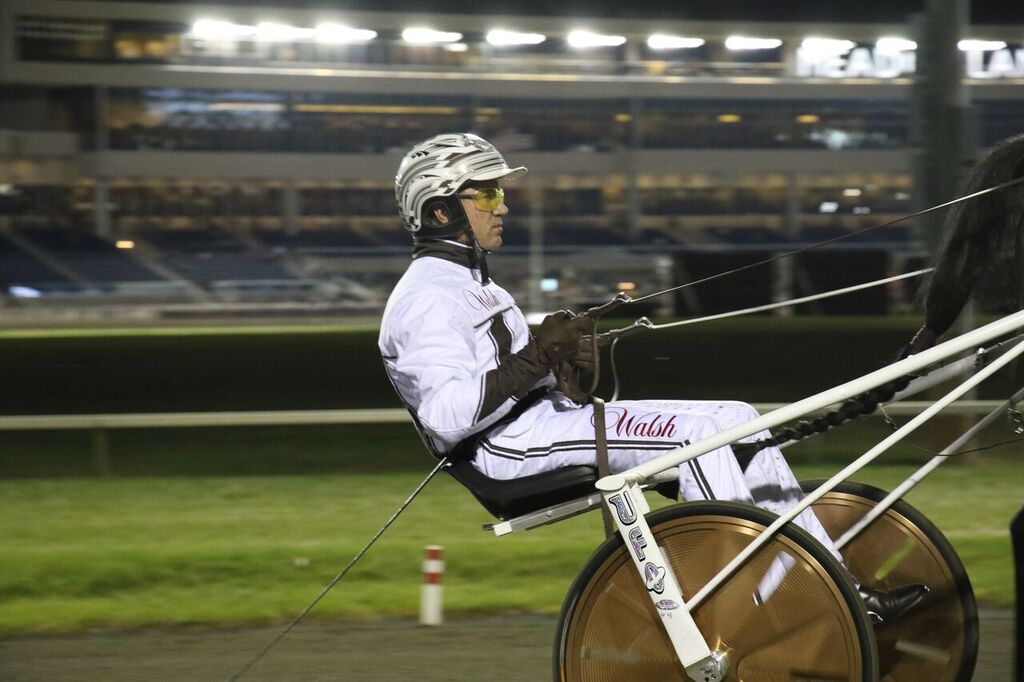
(Photo by Mark Hall)
The 2004 Metro final was supposed to be all about Village Jolt, but few expected Rocknroll Hanover to deliver the finishing blow at 31-1 and raise driver Brian Sears, a relative newcomer to Grand Circuit action, to harness racing stardom.
That year was a good one for Brian Sears as he put in his second season driving full time at the Meadowlands and finished second to Ron Pierce in the winter/spring/summer meet driver standings with 227 wins and $4.8 million in purses.
The Meadowlands finished its meet in August and Sears decided he would return to his former home base of The Meadows for stakes action. In the meantime, trainer Brett Pelling had sent Rocknroll Hanover to Mohawk Racetrack in Ontario for the eliminations of the Metro Pace, where Pierce drove him to a third-place finish.
Pierce elected to drive heavily favored Village Jolt in the $933,086 Metro final. Sears had driven Rocknroll Hanover in a pair of previous starts. Pelling asked him if he wanted the opportunity to grab the lines.
The next part is nothing short of history on that September night.
“I think we were down to the quarter in 25.4,” Sears said with a grin. “The numbers for a 2-year-old pacer, they were incredible. He was something.”

(Photo by Mark Hall)
Rocknroll Hanover would release Village Jolt past the quarter to take a two-hole ride through more torrid fractions, then powered through in the stretch to take Sears to the winner’s circle while obliterating the 2-year-old pacing world record with a 1:49.4 victory.
“Next thing you know, you’re on a plane three different times a week,” said Sears. “I was like ‘Oh, man.’”
It wasn’t the easiest ride to the top for Brian Sears, as the “White Knight” had to put his time in as a youngster with his father Jay Sears’ stable. The elder Sears was an accomplished horseman in his own right, winning more than 1,500 races and $4 million in purse earnings in the bike while racing between Vernon Downs in upstate New York and his winter base of Pompano Park in Florida. The younger Sears would start the school year in Vernon, then further his education in Florida for the colder months before coming back to Vernon to wrap things up again in June.
“It was hard switching schools, but it creates your personality,” Sears said. “Being able to go to south Florida and being exposed to that different lifestyle.”
Sears scored his first win as a driver while he was still in high school aboard his father’s trainee, Alicia Blue Chip, in 1984, but had other plans for his future. He enrolled in a pre-veterinary program after high school, but couldn’t shake the bug of being in the bike.
“I left college early to become a driver–at least that’s what I tell people,” Sears said with a laugh. ”When you grow up in the business and start racing horses when you’re still in high school, I don’t know how they ever thought I was going to get away from it.”
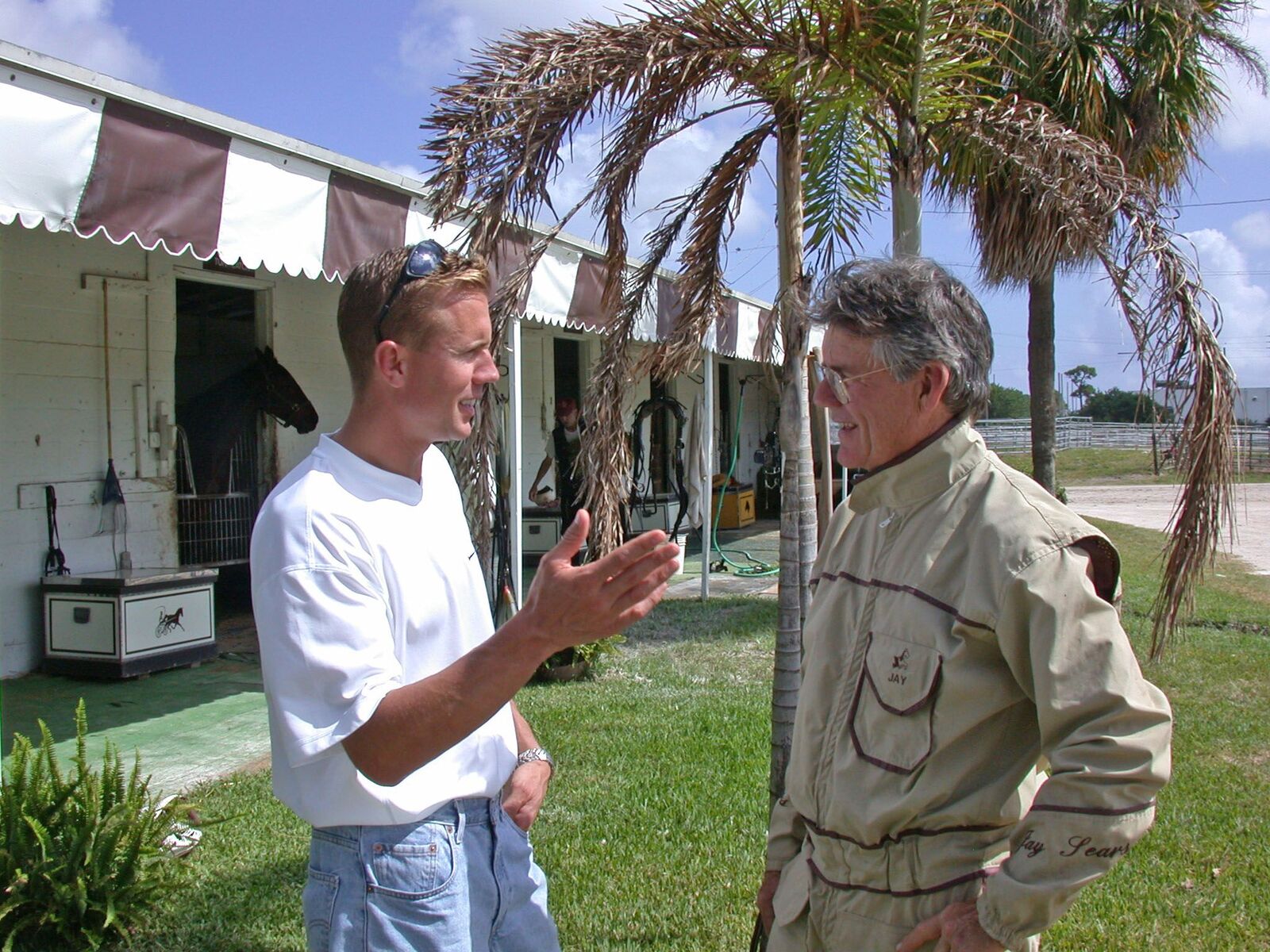
For a change of pace from The Meadows, Sears spent some time in 2002 and 2003 driving at Pompano Park, where his father, established horseman Jay Sears, kept a stable. (Photo by Ed Keys)
Sears began a catch-driving career at Vernon Downs, switching to Pompano Park when his father went south for the winter. He was awarded the Dick Mumpton Memorial award for most promising driver at Vernon Downs, then scored 99 wins and purse earnings of $215,124 in 1991 in his eighth year driving while being named the Rising Star Award winner by the U.S. Harness Writers Association.
“At that time in your career, everything means a lot to you,” Sears said. “Every little acknowledgment of your success is a pretty big deal.”
Then came the first big leap of his career, as Sears made the move to The Meadows in Pennsylvania in 1994 with his five-horse stable to make his mark as a catch-driver.
“I was still going to Pompano in the winter time and I wasn’t getting any quality drives or anything like that,” Sears said. “So I started looking at The Meadows; it was a place that raced year-round, but the purses were pretty good and I got a lot of opportunity after I was there. Even after a few nights I was getting five or six drives a night.”
It was almost instant success for Sears, who had his first $1-million season at The Meadows in 1994 while winning more than 300 races, a feat he has continued to accomplish every season since.
Trainer Virgil Morgan Jr. arrived at The Meadows at the same time as Sears and was stabled in the same barn as the pair of 20-somethings tried to make it in the business.
“He’s driven for me as much as I can get him,” Morgan said. “If there is one word that can describe Brian, it is ‘class.’ He is a classy driver and he is kind to a horse. He knows how to keep one fresh and that made my job so much easier with Mister Big and Pet Rock with the seasons they had to endure.
“When the money is down, he is who you want on your horse. Brian doesn’t get rattled and I have never seen him get nervous. He is the Tom Brady of harness racing: calm, cool and collected. In driving and in life, he is just a class act.”
Someone who has watched Sears closely over the years is track announcer Roger Huston.
“I’m tickled to death for him,” Huston said of Sears’ coming induction into the Hall of Fame. “I have watched him over his career from Pompano to The Meadows to now and you can’t really put anybody else ahead of him. He worked hard at his craft and he always puts his horses in a position to win. It’s an honor well-deserved. You need to get a good foundation for the big time and he definitely got that at The Meadows.”

Roger Huston introduced Sears at the Dan Patch Awards in 2010 when Sears received Harness Tracks of America’s Driver of the Year Award. (Photo by Mark Hall)
Sears finished second to Dave Palone in The Meadows drivers’ standings for nine straight seasons before starting to think about a change of venue.
He traveled to Pompano Park late in 2002 and took the driving title that season at the five-eighths-mile track.
“I went down there for a drivers’ competition and the weather was good, so I said ‘Why not stay?’” Sears said. “Then I got a lot of wins and a lot of publicity and people said ‘Just go to the Meadowlands.’ I went back to The Meadows for a couple weeks and decided I had enough of that and it was time to make a move.”
Sears followed the advice he was given and went to the Meadowlands in East Rutherford, N.J., to attempt to make the big time.
“I wasn’t really sure how keen I was on it at the start and thinking if this was the lifestyle I wanted to have,” Sears said. “Everybody is driving up and down the New Jersey Turnpike and stuck in traffic. I had to ask myself ‘Is this really for me?’”
But Sears stuck it out and was rewarded.
“You’re thrown in and penciled in on whatever you can get, then you start doing some good and eventually you’re not being penciled in–you’re being left on them,” he said. “At the Meadowlands, there was at least 10 drivers there and if you won one out of every 10 races that was pretty good.”
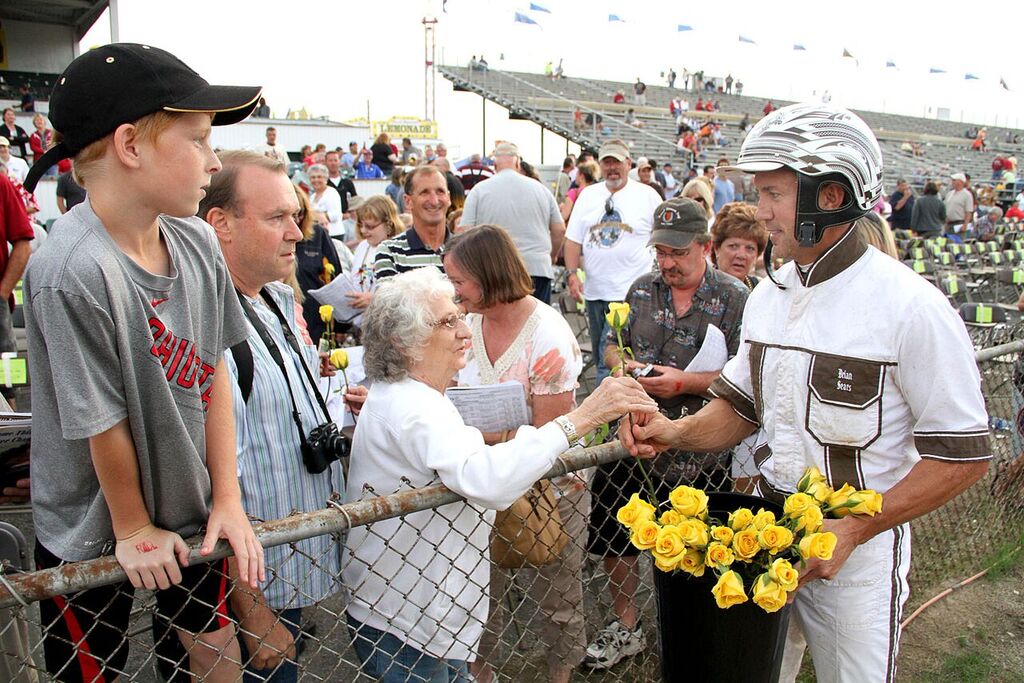
Sears handed out yellow roses to fans after winning the 2013 Little Brown Jug with Vegas Vacation. (Photo by Mark Hall)
His first Breeders Crown win came in 2003 aboard 3-year-old filly trotter Stroke Play, but it was the 2004 season where his career picked up with Rocknroll Hanover in the Metro and three Breeders Crown wins aboard Housethatruthbuilt, Yankee Slide and Western Terror en route to a $10-million season for the driver.
Sears would drive for the top stables in the sport, but never tied himself down, leaving the door open for a mount on whomever the top horse was at any given time.
“I never felt comfortable with that,” Sears said of committing to one stable entirely. “You have to take the horse that will give you the best opportunity. But since the business has shrunk so much, it is harder to do. There is so much power in certain stables; it is not spread out like it used to be.”
2005 was even more success for Sears, as he won 406 races and banked $15 million, in what was then an all-time seasonal record for earnings by a driver.
“It wasn’t like I was trying to set a record or anything, either,” Sears said. “I just had a lot of good horses to drive and I didn’t have to have a million starts to do it. I took a vacation and went down to see my parents during the holidays and enjoyed that, but I just had so many good horses and the purses were so good.”
The Grand Circuit ride continued for Sears as he approaches 10,000 career wins and more than $180 million in the bank while driving some of the greatest horses in the sport and winning nearly every Grand Circuit event.
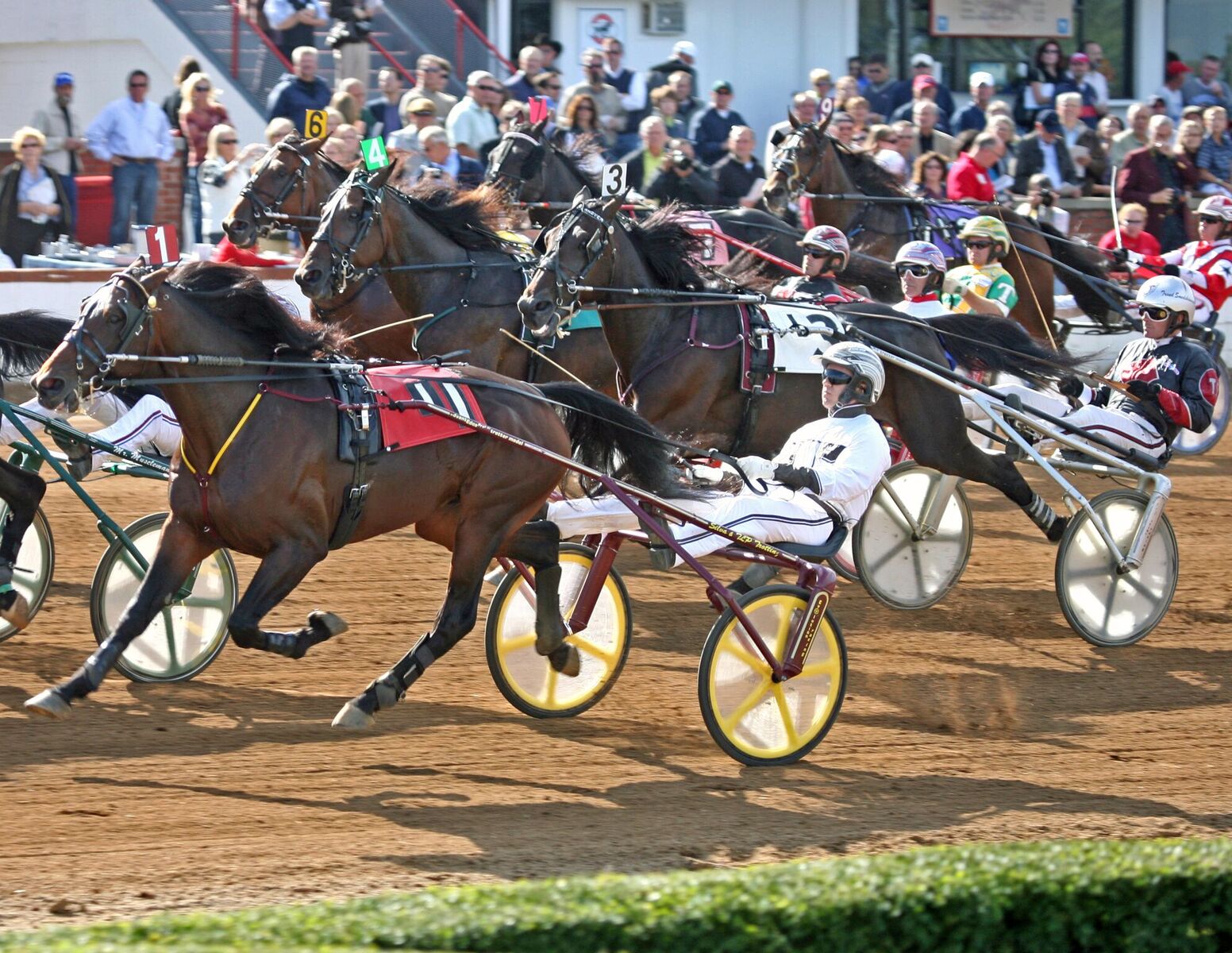
Sears was the main driver for 2009 Horse of the Year Muscle Hill, steering him to wins in such classics as the Hambletonian, the Canadian Trotting Classic, the Kentucky Futurity (shown) and the Breeders Crown. (Photo by Mark Hall)
On Saturday, Aug. 8, 2009, Sears recorded the richest earnings day for a driver in harness racing history. That day, Sears captured the $523,600 Peter Haughton Memorial with Holiday Road, the $783,042 Hambletonian Oaks aboard Broadway Schooner, and the $1,520,333 Hambletonian with Muscle Hill. The day was supplemented by two overnight wins and a second-place finish in the $328,750 U.S. Pacing Championship with Mister Big, giving him $1,555,674 in earnings on one program.
“It was a big day,” Sears said. “Pretty wild. I never had a feeling like winning the Oaks with Broadway Schooner because it was me, Jack Moiseyev, Paul MacDonell and Ron Pierce all right there and I said ‘Ah, I just got nailed.’ Then when they put her number up on the board I just got goosebumps. Then I said ‘OK, I better calm down,’ because I had to drive the Hambletonian the very next race.
“With Muscle Hill, it was a great relief crossing the wire. I was supposed to win it and I just didn’t want any bad luck or anything stupid to happen.”
Sears won the 2013 Hambletonian final with Royalty For Life in the crowning moment of trainer George Ducharme’s career.
“He is a quiet guy until you get to know him,” Ducharme said. “He keeps a horse quiet, which is like his personality. He doesn’t rev a horse up and get it excited. It just comes out of his hands into the horse. He fits right into the Hall of Fame with the great horses that he has driven and never let his ego get ahead of him.”
Grand Circuit action subsided for Sears in 2016, as the 49-year-old switched his focus to Yonkers Raceway in New York and shied away from travel. Since 2011, Sears makes the 30-minute drive across the Hudson River from Secaucus, N.J., instead of staying a regular at the Meadowlands.
“When you look at the purses, you don’t have people shipping into New Jersey to race for $5,000,” Sears said. “At Yonkers, the money is great, but I do miss racing the young horses. But racing the young horses comes with all the travel and if you aren’t driving the best one, it’s hard to do.
“And you know, it’s hard work when you’re not racing them all the time and you need to learn all the other horses. That’s the thing with the Grand Circuit: you either need to do it or don’t. That’s why I’m leaning toward doing it this year.”
Sears said nothing compared to the Meadowlands in its heyday.
“I just feel so fortunate that I caught the last few years of when the Meadowlands was the Meadowlands,” he said. “There is nothing like it. Racing quality horses on a nightly basis with the competition that we had over there was pretty intense. It was so professional.”
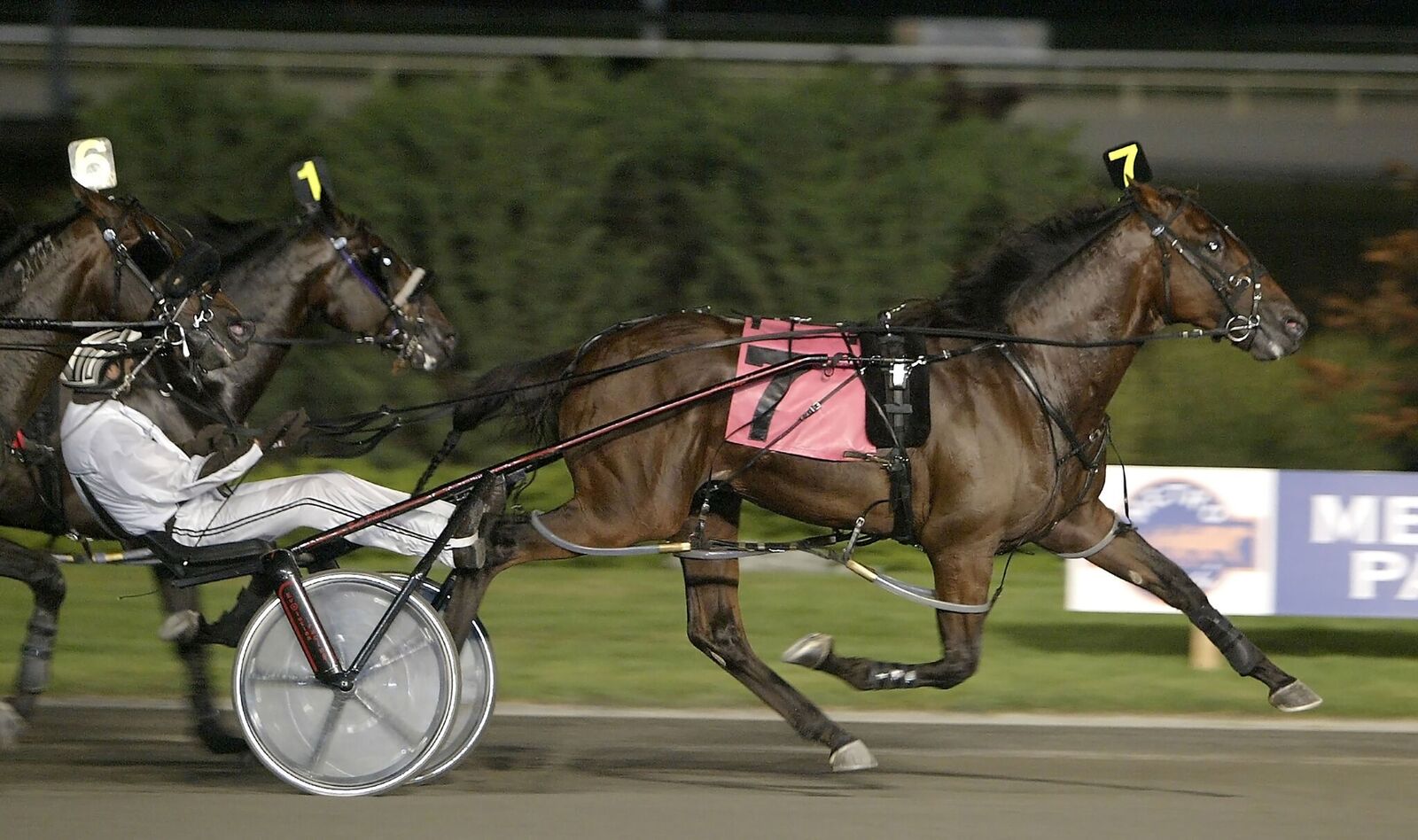
Not long after joining the driving colony at the Meadowlands in 2003, Sears saw his career explode when he won the 2004 Metro Pace with longshot Rocknroll Hanover (shown), plus three Breeders Crowns aboard Housethatruthbuilt, Yankee Slide and Western Terror-all en route to a $10-million season. (Photo by New Image Media)
The pace was severely slowed down for Sears in 2016 with him sticking to Yonkers with a few scattered trips to stakes competition.
“It definitely wears on you,” Sears said of the constant travel required for a Grand Circuit campaign. “I have enjoyed a quality lifestyle and that doesn’t necessarily mean running around all the time. But I do like to mix it up a little bit–get away from Yonkers and go for sire stakes at Pocono or Vernon. Hitting the road with some good guys and seeing friends you haven’t seen in awhile.”
Sitting at the Hall of Fame Award dinner at the Harness Racing Museum and Hall of Fame in Goshen, N.Y., on July 2, Sears will be thinking about when everything meant more and he had no idea how far he would ever come.
“I’m not really an ‘in the moment’ kind of guy,” Sears said. “But I’ll just think about things like when I went to The Meadows, I was stabled with Virgil Morgan Jr. I had five horses and he probably had eight and we hung out and worked out together then we went our separate ways. Then to reconnect after all those years and drive a horse like Mister Big for him, that’s one of the things I love about this business.”
